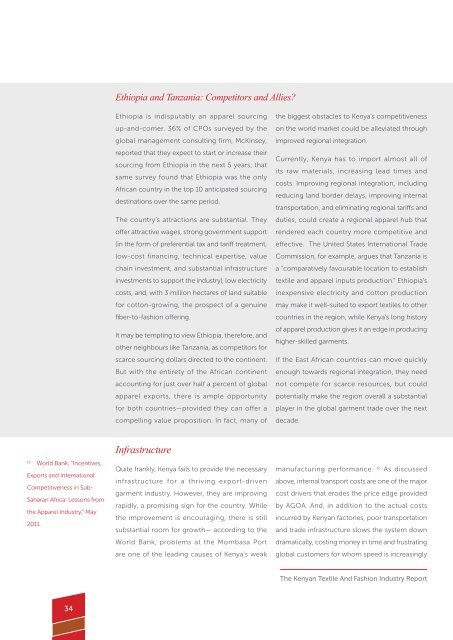Create successful ePaper yourself
Turn your PDF publications into a flip-book with our unique Google optimized e-Paper software.
Ethiopia and Tanzania: Competitors and Allies?<br />
Ethiopia is indisputably an apparel sourcing<br />
up-and-comer. 36% of CPOs surveyed by the<br />
global management consulting firm, McKinsey,<br />
reported that they expect to start or increase their<br />
sourcing from Ethiopia in the next 5 years; that<br />
same survey found that Ethiopia was the only<br />
African country in the top 10 anticipated sourcing<br />
destinations over the same period.<br />
The country’s attractions are substantial. They<br />
offer attractive wages, strong government support<br />
(in the form of preferential tax and tariff treatment,<br />
low-cost financing, technical expertise, value<br />
chain investment, and substantial infrastructure<br />
investments to support the industry), low electricity<br />
costs, and, with 3 million hectares of land suitable<br />
for cotton-growing, the prospect of a genuine<br />
fiber-to-fashion offering.<br />
It may be tempting to view Ethiopia, therefore, and<br />
other neighbours like Tanzania, as competitors for<br />
scarce sourcing dollars directed to the continent.<br />
But with the entirety of the African continent<br />
accounting for just over half a percent of global<br />
apparel exports, there is ample opportunity<br />
for both countries—provided they can offer a<br />
compelling value proposition. In fact, many of<br />
the biggest obstacles to Kenya’s competitiveness<br />
on the world market could be alleviated through<br />
improved regional integration.<br />
Currently, Kenya has to import almost all of<br />
its raw materials, increasing lead times and<br />
costs. Improving regional integration, including<br />
reducing land border delays, improving internal<br />
transportation, and eliminating regional tariffs and<br />
duties, could create a regional apparel hub that<br />
rendered each country more competitive and<br />
effective. The United States International Trade<br />
Commission, for example, argues that Tanzania is<br />
a “comparatively favourable location to establish<br />
textile and apparel inputs production.” Ethiopia’s<br />
inexpensive electricity and cotton production<br />
may make it well-suited to export textiles to other<br />
countries in the region, while Kenya’s long history<br />
of apparel production gives it an edge in producing<br />
higher-skilled garments.<br />
If the East African countries can move quickly<br />
enough towards regional integration, they need<br />
not compete for scarce resources, but could<br />
potentially make the region overall a substantial<br />
player in the global garment trade over the next<br />
decade.<br />
16<br />
World Bank, “Incentives,<br />
Exports and International<br />
Competitiveness in Sub-<br />
Saharan Africa: Lessons from<br />
the Apparel Industry,” May<br />
2011.<br />
Infrastructure<br />
Quite frankly, Kenya fails to provide the necessary<br />
infrastructure for a thriving export-driven<br />
garment industry. However, they are improving<br />
rapidly, a promising sign for the country. While<br />
the improvement is encouraging, there is still<br />
substantial room for growth— according to the<br />
World Bank, problems at the Mombasa Port<br />
are one of the leading causes of Kenya’s weak<br />
manufacturing performance. 16 As discussed<br />
above, internal transport costs are one of the major<br />
cost drivers that erodes the price edge provided<br />
by AGOA. And, in addition to the actual costs<br />
incurred by Kenyan factories, poor transportation<br />
and trade infrastructure slows the system down<br />
dramatically, costing money in time and frustrating<br />
global customers for whom speed is increasingly<br />
The Kenyan Textile And Fashion Industry Report<br />
34


